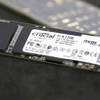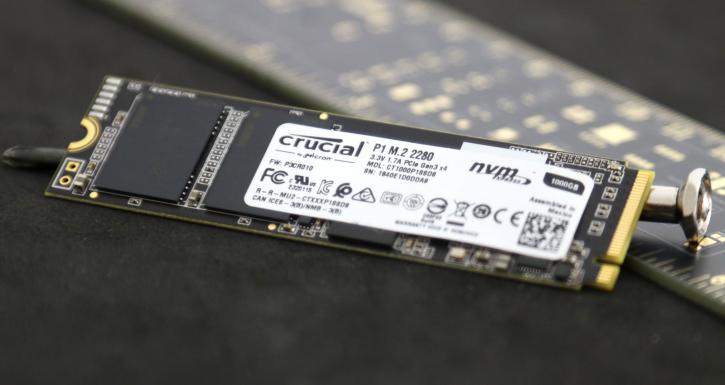Final Words & Conclusion
Final Words & Conclusion
It is fantastic to see the first QLC SSDs on the market. I say fantastic as QLC NAND (4-bits written NAND), is going to be the game changer in the future. The denser written NAND cells allow for more storage inside that same package. A fantastic example is a product tested today, we see a small 2280 PCB holding just two NAND chips, while the puppy can store a full terabyte of data. That said, the industry faces a couple of challenges, the end-users will not likely 'trust' QLC in terms of a number of writes and reliability. We have seen exactly the same with TLC, which now is an accepted NAND storage standard. The TWB values are okay, Crucial, however, tops this unit off with a 5-year warranty, which is really nice and also something that QLC needs in terms of the consumer trust.
QLC Write hole
QLC faces some challenges, we noticed a dropoff in performance once the SSD was written full half its size as well as with mixed heavy workloads, however, we expect that to be fixed with a firmware issue. The continuous writing is also heavily dependant on a DRAM and SLC cache buffer, once these run dry, the M2 unit could drop back to 100 MB/sec writes (see example below).
In the above example after a 120+ GB written the write performance caved. If we stopped copying for a few minutes, the caches cleared and performance was back.
However, you will have a need to have written dozens of gigabytes constantly before that happens, in our case we'd only notice the effect after writing a massive 120GB. Seen from that metric, this is merely a trivial issue. Remember, to fully utilize the performance that is offered for this NVMe SSD you need a supporting infrastructure and this a motherboard with PCI Express Gen3 (x4) interface and NVMe ready BIOS. NVMe based storage is one the most exciting technologies that we have been following developments closely over the past few years was obviously the development curve of NAND flash-based storage technology. We moved from a "blisteringly fast" 100 MB/sec towards numbers that are 20 to 30 fold of that in the 2000 MB/sec ranges.
Performance
Overall the unit is fast, I did not expect that from QLC writes. But as mentioned, the write performance is really based on the two buffers that Micron created, the SLC written provisioned cache, and then the SDRAM buffer. You will pass a 100 GB writes on this 1TB SSD without noticing a drop in performance, however, once it does kick in, it'will kick in card and perf can drop towards 100 MB/sec in such a setting. But with the caches in place, I find this a very trivial remark though as really, the chances you'll run into it are really slim.
Overall this x4 lane configured running NVMe 1.3 is fast, The sustained and linear performance is good. IOPS performance is good on this SSD, not that you'd even need values in the 200~300K range but it does manage that as long as the caches do not run dry. This SSD writes and reads serious amounts of tiny files in a very fast fashion. We stated it before though, IOPS is not something you as a consumer should worry about too much unless you are doing a lot of database related work or create similar workloads on your PC, but this SSD certainly ranks high within this aspect. The trace tests also show exceptional performance levels, enthusiast class NVMe. Overall the series is impressive. We do need to make a remark on measured Silicon Motion SM2263 controller temperature, it runs hot under load, we measured 80 degrees at the hotspot of the controller with thermal imaging and will cause throttling, there's no doubt here. So please do cool down the product with a proper M2 heatsink, most motherboards supply one default these days. This is the nature of enthusiast-class M2 SSDs these days.
Concluding
For the first QLC SSD drive tested I am not disappointed, however also am not super excited. Granted it's nice, but not perfect. For the price range that can not be expected either. The P1 will need another firmware update as there is something going on with the SSD loaded up with data and a perf drop. Also, you have a huge cache for many gigabytes of writes, but once the buffers run dry, write performance will cave in bigtime. Last but not least, under heavy load, the controller heats up significantly, and while the SM controller can take that heat level fine, it will at one point cause throttling as the controller will thermally prevent and protect itself. All motherboards have an M2 heatsink shield these days, use it and make sure your PC inside has a bit of airflow, and that challenge is fixed.
QLC, my friends, has been introduced to become the most price competitive NAND type in the industry, read my words QLC (and more layered 3D NAND) is the final nail in to coffin of the HDD. Right now, however, yields on QLC NAND are low, ergo it's not competitive enough to fabricate. It will probably take another year before prices are really going to drop as the fabrication process needs more fine-tuning and improvements. Try to imagine a 4TB QLC 3.5" SATA3 SDD at HDD prices, that's what this technology will do. With that in mind, I was a little surprised to see QLC end up on the NVMe M2 form factor as a first release from Micron. Then again, just answered my own curiosity. M2 is higher performance and Micron can ask a bit more money for these SSDs. And that is needed with the aforementioned yield issues I mentioned. Once QLC is tuned with proper yields, regular SATA3 SSDs will follow with very low prices. Prices; the P1 is listed at most price engines already, here are some current street prices, 2 TB costs 499 EUR. Our tested 1TB costs 229 EUR, and the 500GB model I spotted at 114 EUR. So we're looking at roughly 22 cents per GB. While it's a great drive that we have little complaints about, the product pricing will need to come down further as that price is in the TLC NAND SSD territory as well. TBW values are fine, this SSD is rated at 200 TB. So if you write 50GB per day the SSD would last 11 years, I would be comfortable with such a value personally.
In closing, we have little doubt that QLC will last you a long long time. It's a very fast unit, until the caches run dry (but the caches are HUGE, we estimate 100+ GB continued writes before you'd notice it). My main caveat is that the price will need to be lower then it is right now to become attractive enough for the consumers. I mean you can pick up a Crucial MX500 1TB for 150 EUR, and really that's what QLC needs to battle. Regardlessly, we hand out an approved award. Please do be sure to cool down the SSD with an M2 heatsink though.
Recommended Downloads




